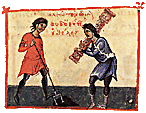 |
|
 |
Concentration of land ownership
 basic characteristic
basic characteristic
 of the system of land ownership of the Late Byzantine period was the concentration of landed property in the hands of the aristocracy and the Church. In comparison to the Middle Byzantine period, the change that took place consisted in the extent of the land that was distributed. Whereas in the previous period, the state would cede to laymen and clerics limited and controlled portions of land, now entire villages with their land and pastures, together with their rights and tax obligations, were handed out. Thus, while the village continued to constitute the most important form of social organisation, the economic autonomy of the community was lost, and was replaced by large land ownership. This meant, however, that the economic bond between the state and the peasantry was weakened almost to breaking-point, of the system of land ownership of the Late Byzantine period was the concentration of landed property in the hands of the aristocracy and the Church. In comparison to the Middle Byzantine period, the change that took place consisted in the extent of the land that was distributed. Whereas in the previous period, the state would cede to laymen and clerics limited and controlled portions of land, now entire villages with their land and pastures, together with their rights and tax obligations, were handed out. Thus, while the village continued to constitute the most important form of social organisation, the economic autonomy of the community was lost, and was replaced by large land ownership. This meant, however, that the economic bond between the state and the peasantry was weakened almost to breaking-point,
 a situation suggesting a process of feudalisation of the rural segment of society. a situation suggesting a process of feudalisation of the rural segment of society.
The institution of protimesis (lit."preference"), the right of preemption or priority, which appeared in the 10th century and continued to exist until the 14th, was the result of the effort on the part of the state to intervene in the concentration of land ownership. According to this institution, when land was to be sold, the neighbours or other farmers of the same community would have priority in the purchase of that land. But, whereas initially this system protected the small landowner, in the 14th century its application came to benefit the great holders who
 had priority in the purchase of the land sold, since it was adjacent to their own. In the 13th century the measure of epibole (lit."imposition"), otherwise called allelengyon ("joint responsibility"), continued to be applied. This meant that the entire village community was collectively liable for the payment of taxes in the event of any small landowner abandoning his property for some reason. had priority in the purchase of the land sold, since it was adjacent to their own. In the 13th century the measure of epibole (lit."imposition"), otherwise called allelengyon ("joint responsibility"), continued to be applied. This meant that the entire village community was collectively liable for the payment of taxes in the event of any small landowner abandoning his property for some reason.
The measures of protimesis and epibole are evidence of the fact that there were still small landowners in the 13th and 14th centuries, since these institutions were meant to protect them. Naturally, the decline of the institutions coincided chronologically with the disappearance of the small landowner.
|